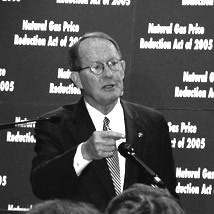
April 8, 2005
Natural gas and solar energy don't often cross paths. But U.S. Sen. Lamar Alexander has proposed a natural gas bill that would rely on increased use of solar energy technology to cushion the natural gas market.
Photo: Sen. Lamar Alexan

|
April 8, 2005 Natural gas and solar energy don't often cross paths. But U.S. Sen. Lamar Alexander has proposed a natural gas bill that would rely on increased use of solar energy technology to cushion the natural gas market. Photo: Sen. Lamar Alexan |
"Our challenge now is to make sure the solar
provisions are part of the cream that gets skimmed off the top and put into the
larger bill."
- Rhone Resch, President Solar Energy Industries Association
Peterborough, New Hampshire [RenewableEnergyAccess.com] This week U.S. Senator Lamar Alexander (R-Tennessee) proposed legislation aimed at providing cushioning for the tight natural gas market, and solar energy has a big role to play in the process. The bill includes strong solar provisions that reflect a new approach to promoting renewable energy throughout the U.S.
Part of the Senator's "Natural Gas Price Reduction Act of 2005" is
a five-year, 30 percent investment tax credit for both residential and
commercial applications of solar energy technology. On its own, the tax credit
is unlikely to be a major market mover, but combined with existing and future
state incentives it could significantly expand deployment for solar power
throughout the U.S.
Success in terms of legislating requirements and incentives for solar and other
renewable energy technologies has almost exclusively occurred at the state
level. The federal government has done relatively little to promote renewable
energy, leaving many policy experts to conclude that renewable energy advocacy's
best efforts should be concentrated at the state level. Federal legislation,
after all, is often only enacted after particular policies become commonplace
throughout U.S. states.
What's new about Sen. Alexander's approach is that it's specifically designed
with state leadership in mind. The bill straddles a fine line between enacting
effective federal incentives for solar while supporting the state-based push for
renewable energy.
"It's not about telling states what to do, but in giving them a
choice," said Rhone Resch, president of the Solar Energy Industries
Association, the solar industry's trade association based in D.C.
That 30 percent tax credit is taken after any existing state credits. The idea
is that the Federal government plays a supportive role to states that are
willing to invest in solar. This will not create a market on its own, says Resch,
but it leverages existing state dollars further and creates an incentive in
those states that are considering renewable energy legislation to go ahead.
"It's a newer model," Resch said. "The real leadership on energy
policy has come from the states, and this bill recognizes that leadership."
The five-year, 30 percent investment tax credit would be capped at $7,500 for
residential solar PV and solar thermal projects, and be unlimited for commercial
projects. A 10 percent investment tax credit currently exists for solar, but
that's not enough to stir the residential market. The credit is even less
effective at inspiring investor confidence in commercial-scale Concentrated
Solar Power (CSP) projects.
With CPS projects in mind, Sen. Alexander's bill includes a Production Tax
Credit (PTC), just like the tax credit the wind power industry has available for
2005, that will provide a 1.8 cents / kWh tax credit for five years. Combined
with the 30 percent investment tax credit during the same duration, a new round
of CSP development could occur -- most likely in the desert southwest.
"This is necessary because this industry hasn't build in a CSP plant in 15
years," Resch said. "Combined, these incentives will reduce the risk
of a project. Investors need assurance in capitol cost and a reduction in
overall commodity price. It's not permanent, but it creates a five year double
credit window."
While these provisions are being hailed by the solar industry as some of the
most exciting recent federal developments towards promoting renewable energy,
they are at the beginning of a long, bumpy Congressional road. The endgame for
legislation like this is that it will be included in a large, comprehensive
energy bill, which will likely be debated and finalized throughout the summer.
Sen. Alexander is Chairman of the Senate Subcommittee on Energy. As a prominent
Republican floating a proposal in an energy bill process that's controlled by
Congressional Republicans, Sen. Alexander's effort stands a better chance of
navigating the congressional road.
"What's unique is that we have a Republican in a leadership position
representing strong solar incentives," Resch said.
Ultimately, though, Senate Energy & Natural Resources Chairman Pete V.
Domenici (R-New Mexico) will play a major role in whether portions of the
Senator's bill survives. So far, that's clearly a possibility according to Sen.
Domenici himself who already commented on Sen. Alexander's proposal.
"I...compliment [Sen. Alexander] for putting forth potential solutions to
the looming natural gas crisis," Sen. Domenici said. "I think some of
his provisions should be included in the comprehensive energy bill we will
mark-up in committee later this spring."
And that's the crux, according to Resch.
"Our challenge now is to make sure the solar provisions are part of the
cream that gets skimmed off the top and put into the larger bill," he said.
Copyright © 1999 - 2005 - RenewableEnergyAccess.com
Please visit www.RenewableEnergyAccess.com for great coverage on energy today!!